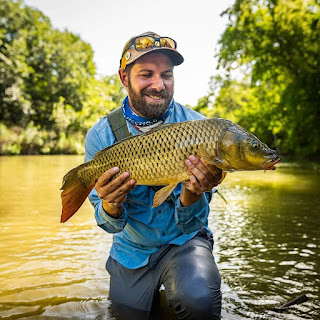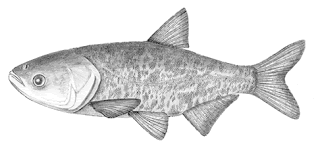Considered a nuisance fish by most anglers in America, carp in Texas seem to be as divisive a topic as the Dallas Cowboys, the legalization of marijuana, or Kinky Freidman. Some love them, many hate them. Discussions about carp can quickly become as heated of a debate as one about UT vs A&M, putting sauce on Bar-B-Que (notice the spelling), or wind turbines. As carp fishing (especially fly fishing) becomes increasingly popular in Texas, this divisiveness may get further entrenched. All sides of the carp debate feel solidly correct, but what is the truth...are they trash fish, do they destroy the environment, are they a prize catch? What are these carp in Texas and what is their impact?
In this five(ish)-part series, Texas Freshwater Fly Fishing, will attempt to dive deeply into the subject to root out as much CORRECT information as possible. Be sure to understand the facts before you make a decision.
Before we get into the controversy that Part 3 - What are their Impacts? might cause, make sure you read Part 1 - What are Carp? (And What Ain't?) and Part 2 - Why are Carp Here? so that you have the background information you need.
Now that you know what "carp" are and how they ended up in the waters here in Texas, Texas Freshwater Fly Fishing will cover the impact that these non-native fish on the waters and fish of Texas.
No doubt, there is a lot of negativity surrounding carp, and because of that these fish are easily hated, vilified, and all-to-often left for dead on a riverbank somewhere. Much of that negativity comes from a misunderstanding of the fish, and a belief that a carp is a carp is a carp, and they are all bad. Some of that negativity is deserved, but much of it is not. Here is what we know about the impact carp have had in Texas.
Bighead Carp and Silver Carp
The full impact of Bighead Carp has probably not been seen yet, and thankfully Silver Carp have not extended their reach too far into Texas. Although they are present in some Texas waters (see Part 2 - Why are Carp Here?), the populations these Asian Carp have thankfully not spread to most of the state yet. However, Bighead Carp and Silver Carp both have a negative impact on the local, native species of fish in places where they are found in large numbers.
 |
| Distribution of Bighead Carp in the United States |
Both Bighead Carp and Silver Carp feed on the same food sources as many other native species (zooplankton and phytoplankton), including all larval fish, some adult fish, and mussels. These species can grow to large sizes, with Silver Carp reaching about 60 pounds and Bighead Carp growing up to 100 or more pounds, they must consume large amounts of food to sustain themselves. Their size and aggressive feeding habits lead them to out-compete many native fish, often reducing the populations of both immature gamefish and their prey.
These are both also prolific spawning fish. Under the right conditions Bighead and Silver Carp can reproduce rather quickly, further increasing their ecological impacts.
And, the most famous aspect of these Asian Carp is their propensity to fly out of the water when startled.
Here is a great piece from PBS NewsHour on Asian Carp. Although it does not address Texas directly, it does show some of the damage that these carp can cause.
Grass Carp
 |
| Grass Carp |
The impact of Grass Carp can be seen on different bodies of water around the state. They can serve a purpose, or they can almost completely wipe out the vegetation of a body of water if not managed properly. On top of that, Grass Carp will also escape, readily seeking flowing waters, leading to damages outside of where they are intended to be.
Although it requires a permit from the state, triploid Grass Carp can be stocked in Texas. The reason they are often introduced into specific waters is to control vegetation growth. And with their veracious appetites', they do a good job of controlling vegetation. Grass Carp can eat up to 300% of their body weight in plants each day. And, with a body weight typically between 65 - 80 pounds (and documented reports of over 400 pounds), Grass Carp eat a lot of plant matter. This can control unwanted weed growth in a body of water, but can also reduce the food sources of native fish that often rely on these native plants for food and cover.
Grass Carp have been effective at controlling unwanted weed growth (especially hydrilla, which is also non-native) in waters around Texas, that is why their stocking is still allowed. However, some of the problems caused by Grass Carp is that they will consume plants in the order they prefer. If they prefer a native grass over an overgrown introduced plant, they will eat that first. This can sometimes compound problems with vegetation, reducing the numbers of native plant-life while allowing the invasive species to continue to grow. It should go without saying, that this reduction in native plant-life can have a negative impact of native species of fish.
Lake Austin is a prime example of Grass Carp populations not only controlling plant growth, but also decimating it. In 2002, Grass Carp were stocked in the lake by the city of Austin. I remember it well because I was bass fishing that lake nearly every day (and catching some great fish too.)
 |
| Lake Austin back when I thought I was cool (circa 2003) |
At that point, the numbers of Grass Carp increased enough that the fish ate all of the hydrilla, milfoil, and much of the native vegetation, severely hurting the bass population, as well as the populations of other native fish. Then, floods in 2016, 2018, and 2019, washed some of these Grass Carp over the dam, and into Lady Bird Lake.
Recently, efforts have been made to reduce the numbers of Grass Carp in Lake Austin and to restore the native plant life in the lake. This restoration had cost taxpayers another $250,000 by 2016. All together, that is a half-a-million bucks spent on one lake because of invasive plants and animals. Oh humans...
Beyond the potential of destroying native plant populations, Grass Carp can also cause algae blooms. Although these fish may eat up to 300 percent of their body in plant matter every day, not all of that gets digested. Only about 50% of what they consume gets digested and the rest is excreted with their waste back into the water. In some places, this has increased the nutrients in the water leading to algae blooms.
Well...enough about Grass Carp, lets move on to the real controversy.
Common Carp
 |
| Common Carp, photo courtesy of Chris Sorel |
Common Carp, like the Asian Carp discussed above, are often vilified as habitat destroyers and a potential threat to "native" (yes, native is in quotations because the fish many people that are vilifying carp for is often Florida-strain Largemouth Bass) fish. Unfortunately for the Common Carp, they do not cause nearly the damage to the freshwaters ecosystems they inhabit as the Bighead, Silver, and Grass Carp do. But, they still take a big brunt of the "carp" blowback. I cannot tell you how many times I have seen comments and posts about needing to kill all the carp (referring to the Common Carp) in a river or lake. Would the elimination of this species impact the native species in a positive way? Lets look at facts.
Lets start with the question, can the Common Carp damage the waters of Texas? The answer, which will make some of you upset, is yes they can. The Common Carp prefers to feed on the bottom. In doing so, they can uproot shallow rooted aquatic plants, muddying the water and competing for resources with native species. Also, their waste can also further reduce water quality by releasing phosphorous and therefor, potentially increasing algae growth. On top of all that, the Common Carp can and will consume fish eggs, including the eggs of native species.
That being said, the Common Carp has been in our waters here in Texas for over 140 years and has not been blamed for the extinction of one species here in Texas. Humans and the disruption of the flow of our rivers and streams here in Texas has had a much larger impact.
All that said, with so much being thrown at me about how bad Common Carp can be for a body of water, I tried to find Texas freshwater fisheries that have seen a decline in fishing due to the Common Carp. The lake that got brought to my attention the most was Lake Sweetwater. So I wanted to find out the problem that Common Carp have caused there.
Construction of Lake Sweetwater was completed in 1930 by damming up Bitter Creek, near Sweetwater, Texas. Since that time, the lake has been stocked with fish, developments (including a golf course) have grown up around the lake, and it has seen a few, pretty drastic, water level fluctuations.
 |
| Water level of Lake Sweetwater over time: from Water Data For Texas |
 |
| Lake Sweetwater from Google Maps |
It is the same story in a few other bodies of water around Texas. Common Carp get blamed for the poor water quality and fishing in a lake, but if you look deep, they usually are not. Common Carp have co-existed with native populations of fish for over 140 years in Texas, long enough to be considered naturalized in the state. Am I promoting the spread of Common Carp to water that do not have them? No. But would I vilify and call for the elimination of all the Common Carp in a body of water? No, not any more (I would have years ago before I knew any better.) And, if you think Common Carp are bad for our waters in Texas, make sure you consider the impact that dams and the spread of numerous other non-native, highly-prized, game species have had.
Common Carp can provide a unique angling experience, and that not be your cup of tea, but that doesn't mean that they should be killed off. We will start getting into fly fishing for carp in the next set of articles!
Further Readings:
Common Carp at Lake Sweetwater; 01/11/2021
LakeSweetwater.com: Lake Sweetwater History
Water Data For Texas: Lake Sweetwater
Texas Parks and Wildlife: Golden Alga Bloom Reports
USGS: Causes of Toxic Golden Algal Blooms Determined
Texas Parks and Wildlife: Carp Fishing in Texas By Mukhtar Farooqi
Texas Invasive Species Institute: Common CarpTexas Parks and Wildlife: Common Carp (Cyprinus carpio)
TPWD: Fighting Aquatic Invaders
Texas Parks and Wildlife: Grass Carp (Ctenopharyngodon idella)
Reporting Texas: Renewing Battle Against the Fish Eating Lake Austin
U.S. Fish and Wildlife Service: Grass Carp Inspection and Certification Program
U.S. Fish and Wildlife Service: Common Carp (Cyprinus carpio) Ecological Risk Screening Summary
Minnesota Department of Natural Resources: Common carp, German carp, European carp (Cyprinus carpio)
National Park Service: History of Common Carp in North America
Texas Parks and Wildlife: Smallmouth Buffalo (Ictiobus bubalus)
Texas Parks and Wildlife: Texas Non-Game Freshwater Fishes, Mark Klym & Gary P. Garrett
Texas Invasive Species Institute: Bighead Carp, Hypophthalmichthys nobilis
Texas Monthly: How Fishing in Texas Got So Good—and Kind of Weird




Comments
Post a Comment